The History of Bimetallism in the United States
By J. Laurence Laughlin
It may not be necessary to inform readers again that I have aimed in this book to present only the facts bearing on the experiments of the United States with metallic money. No special attention, therefore, has been devoted to the theory of bimetallism or to the larger principles of money involved in current discussions. In a historical study, such as this aims to be, there is neither space nor propriety for an extended treatment of principles. Hence I do not wish to be regarded as having tried to “settle the money question” merely by this book, even though the facts given must necessarily have an important bearing on the acceptance or rejection of current schemes. In due time I hope to present a careful discussion of the principles of money, and also an examination of the logic and theory of bimetallism. [From the Preface to the Fourth Edition]
First Pub. Date
1885
Publisher
New York: D. Appleton and Co.
Pub. Date
1898
Comments
4th edition.
Copyright
The text of this edition is in the public domain.
- Preface to the Fourth Edition
- Preface to the First Edition
- Part I, Chapter I, The Arguments of Bimetallists and Monometallists
- Part I, Chapter II, The Silver Period, 1792-1834
- Part I, Chapter III, Cause of the Change in the Relative Values of Gold and Silver, 1780-1820
- Part I, Chapter IV, Change of the Legal Ratio by the Act of 1834
- Part I, Chapter V, The Gold Discoveries and the Act of 1853
- Part I, Chapter VI, The Gold Standard, 1853-1873
- Part I, Chapter VII, The Demonetization of Silver
- Part II, Chapter VIII, The Production of Gold since 1850
- Part II, Chapter IX, India and the East
- Part II, Chapter X, Germany Displaces Silver with Gold
- Part II, Chapter XI, France and the Latin Union
- Part II, Chapter XII, Cause of the Late Fall in the Value of Silver
- Part II, Chapter XIII, Continued Fall in the Value of Silver since 1885
- Part III, Chapter XIV, Silver Legislation in 1878
- Part III, Chapter XV, Operation of the Act of 1878
- Part III, Chapter XVI, Act of 1890
- Part III, Chapter XVII, Cessation of Silver Purchases, 1893
- Appendix I, Production of Gold and Silver in the World
- Appendix II, Relative Values of Gold and Silver
- Appendix III
- Appendix IV, Coinage Laws
- Appendix V, Coinage Statistics
- Appendix VI
- Appendix VII
Relative Values of Gold and Silver
Appendix II
For the time previous to the discovery of America there are many fanciful estimates of the relative values of gold and silver. Jacob
*1 thus briefly sums up the situation:
“Although the amount of silver in circulation as money at all times must have been greater than that of gold, yet, as the gold has six times the durability of silver, the relative value of the two metals to each other could not be maintained unless the mines produced the two metals in proportion to the loss on them by wear respectively. It seems probable that the due proportion was kept up during the existence of the Roman power, and through the dark ages which succeeded, till the discovery of America, and till the dispersion over the world of the surplus produce of silver above that of gold. The value of gold to silver had varied but little before the mines of Potosi were discovered. Among the Romans gold to silver seldom varied more than from nine to eleven for one, that is, a pound of gold was rarely worth either more than eleven or less than nine pounds of silver; nor did the relative value of the metals fluctuate more in the long course of centuries to the time when the new sources of mineral wealth in the western world were in full activity.”
A. Average Ratios of Silver to Gold, by Periods, since 1500.
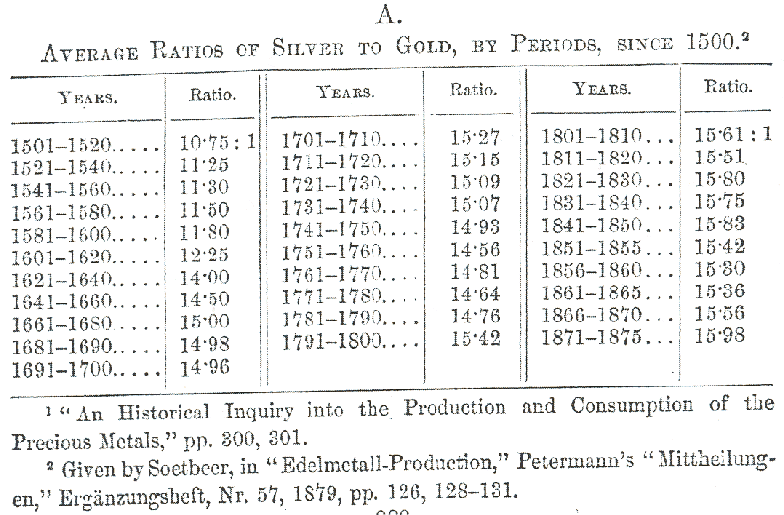
B. Ratios of Gold to Silver, given Yearly since 1687.
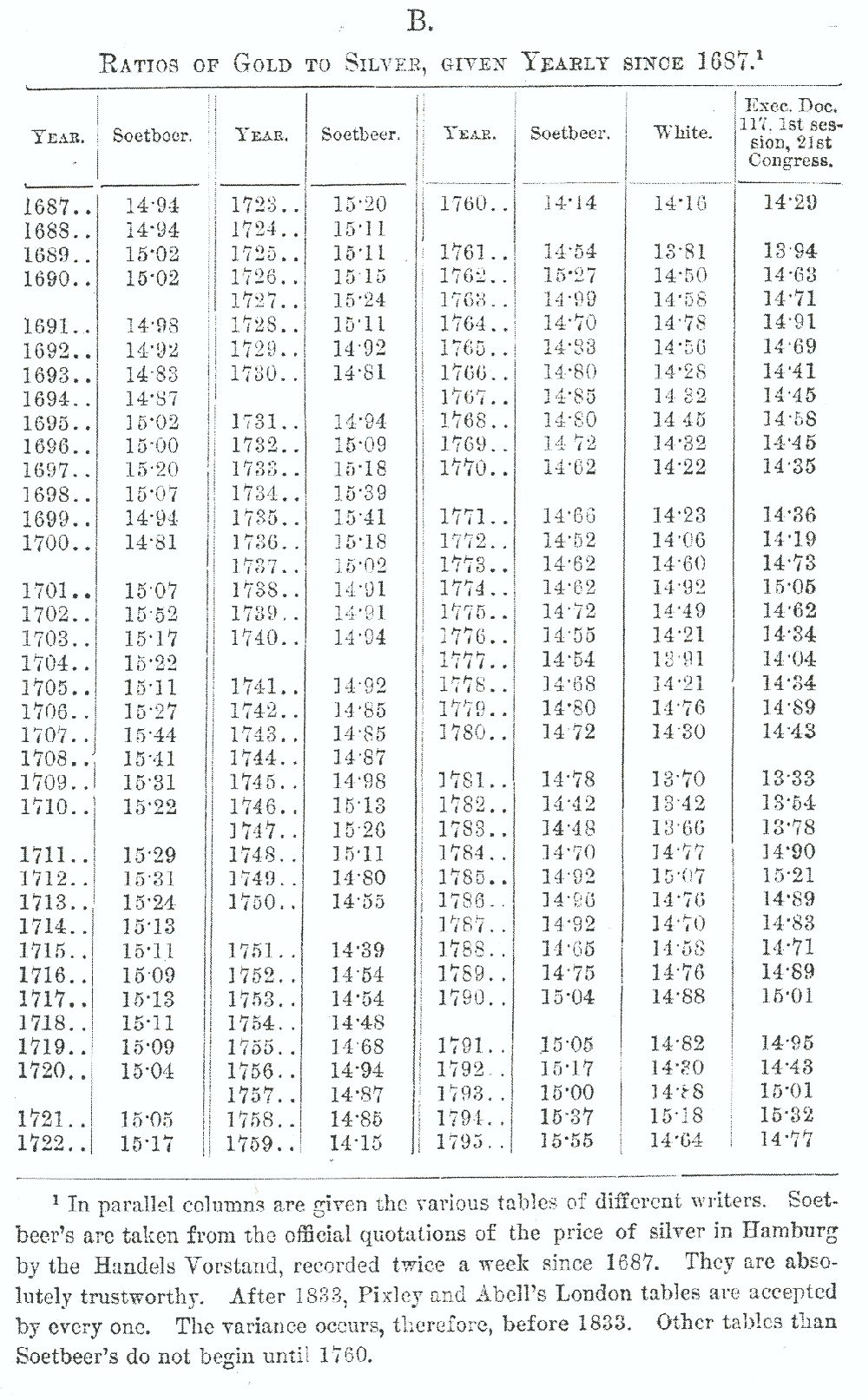
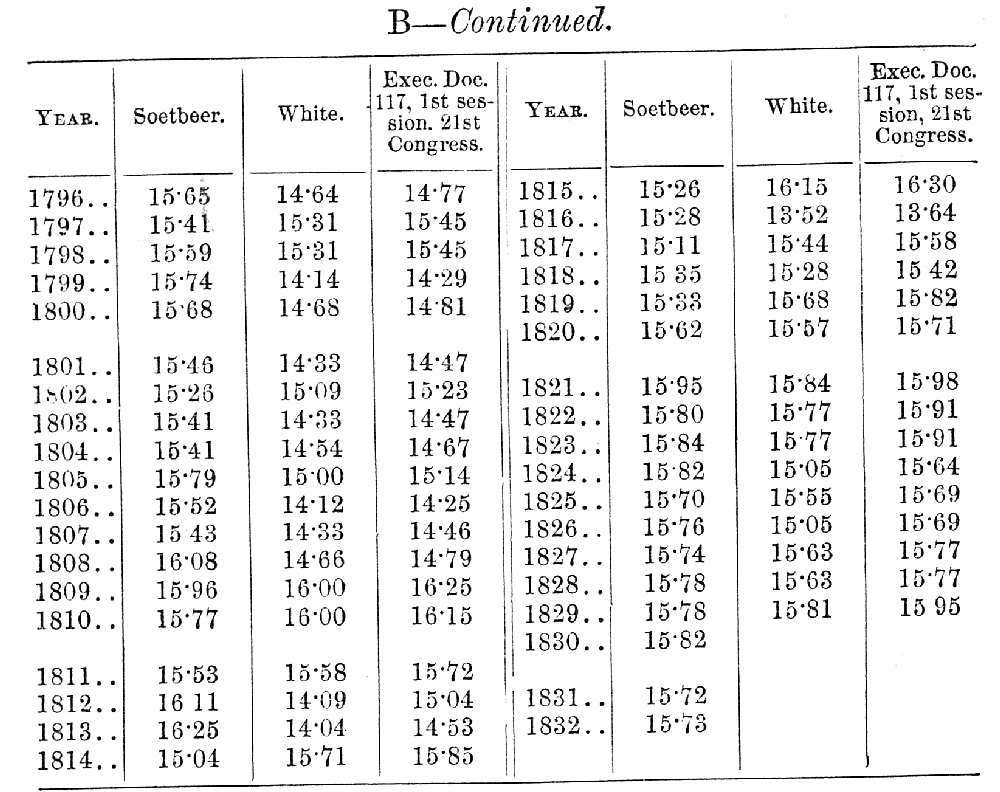
The table headed “White” was prepared by John White, the cashier of the United States Bank, in a Report to the Secretary of the Treasury, November 16, 1829. (See “Report of 1878,” pp. 647-649; also cf. p. 624.) Accompanying White’s table are the following authorities: “Mr. Mushet, Mr. Wheatly, ‘Monthly Magazine,’ ‘Bullion Report,’ Mr. Tooke, Mr. Ricardo, Chancellor of the Exchequer, Governor of the Bank.” This is a varied list.
Soetbeer has pointed out that White’s table is untrustworthy, because eve have no knowledge what sort of quotations were used, nor how the averages were calculated. Owing to the issue of paper between 1797 and 1819, the period of the Bank Restriction Act, the Hamburg quotations would unquestionably be more reliable. Soetbeer has pointed out what seem to be palpable errors in the White table. In 1761 it is quite improbable that the ratio fell below 14:1 and then rose the next year 5 per cent. Moreover, in White’s table the following ratios occur:
| 1781 | 13.33 | corresponding to | 70¾ | d. |
| 1782 | 13.54 | “ | 69 3/8 | d. |
| 1783 | 13.78 | “ | 68½ | d. |
| 1784 | 14.90 | “ | 63¼ | d. |
while the Hamburg quotations give:
| 1781 | 14.78 | corresponding to | 63¾ | d. |
| 1782 | 14.42 | “ | 65 3/8 | d. |
| 1783 | 14.48 | “ | 65 1/8 | d. |
| 1784 | 14.70 | “ | 64 1/8 | d. |
There is absolutely no known reason to account for so sudden a change as that indicated by White’s figures in 1784, while at Hamburg the ratio remained steady, or nearly so.
In addition to this, Jefferson says that the market ratio in 1782 was 1:14.5 in the United States, and Morris points to the fact that the ratio was nearly 1:15 in England (“Report of 1878,” pp. 428, 441). The figures of White for the years 1812, 1813, and 1816 are undoubtedly incorrect. According to his ratios, silver changed between 1810 and 1816 from a ratio of 13.52:1 to 16.15:1, for which there appears to be no sufficient reason in the facts known to us. It seems as if the figures of 13.52 for 1816 were a mistake for 15.52. For these reasons I can not place much, if any, reliance on White’s table, and have, therefore, followed Soetbeer’s figures in the course of my investigation.
The table given above, from a United States document, is evidently based on the same material as White’s. Although in every ratio the figures are different from White’s, yet the differences are usually very slight (except for 1812), and follow the same general direction. Even in the exceptional figures of 1781-1783, and 1816, there is the same trouble as in White’s table. These figures are given in the “Report of 1878,” p. 583; are made the basis of a table of ratios by Alexander Del Mar in the “Report of the United States Silver Commission of 1877,” vol. i, appendix, p. 67; are stated in C. P. White’s “Report, No. 278, 1833-1834,” p. 96; and are quoted by H. R. Linderman, in his report as Director of the Mint, 1876, p. 46. But the table, as well as the White table, can be regarded as not sufficiently trustworthy to base any conclusions upon.
C. Pixley and Abell’s Tables of the Average Annual Ratios of Gold to Silver since 1833.
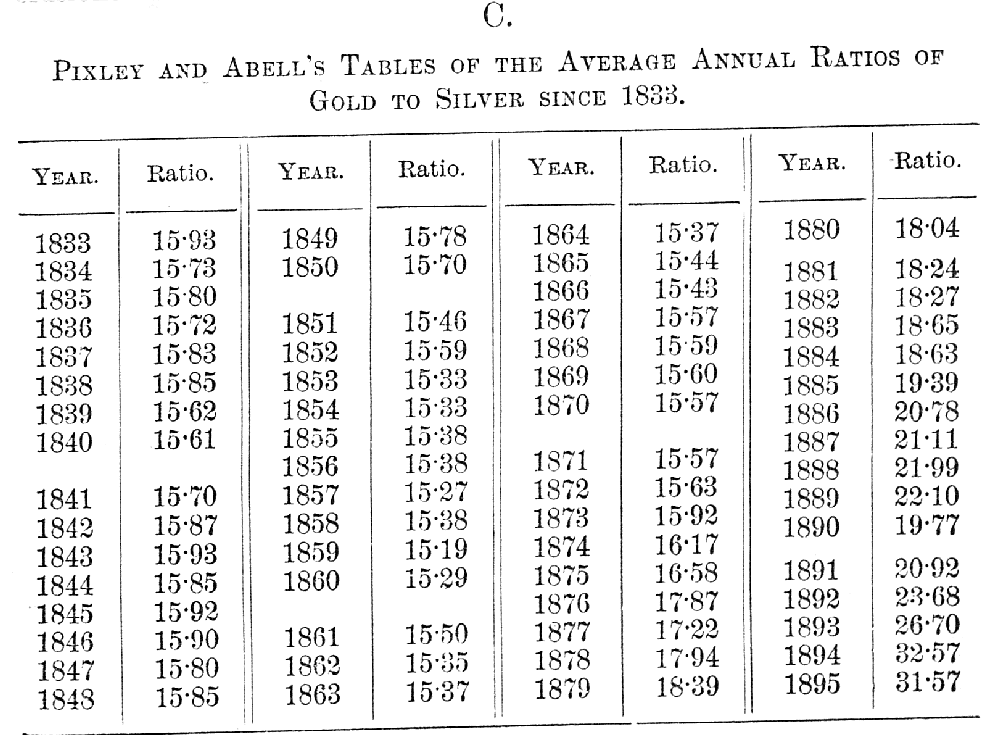
D. Average Yearly Price of Standard Silver per Ounce in London since 1833.

E. Monthly Quotations of Bar-Silver per Ounce Standard, in Pence, at London, since 1871.
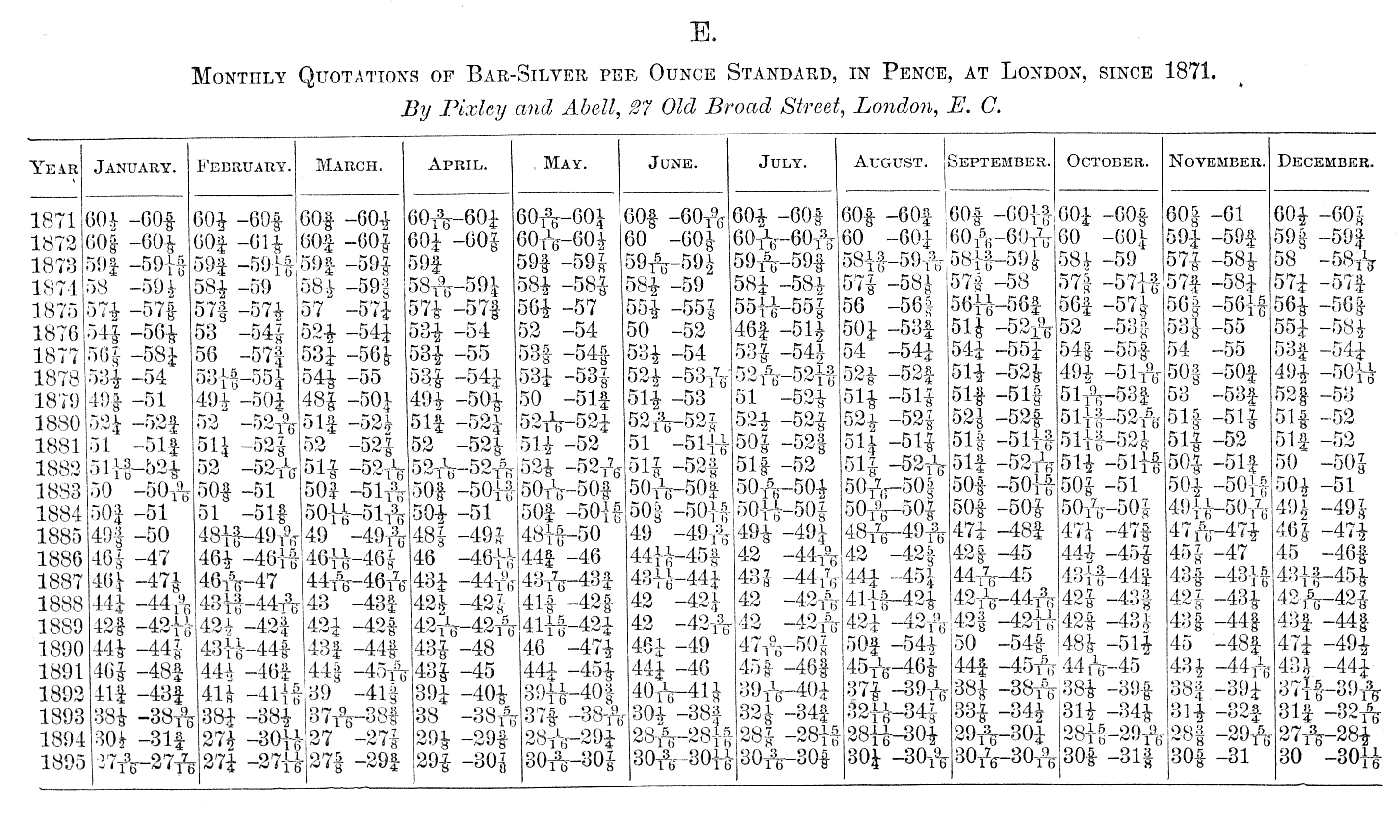
F. Ratios of Silver to Gold, by Months, since 1845.
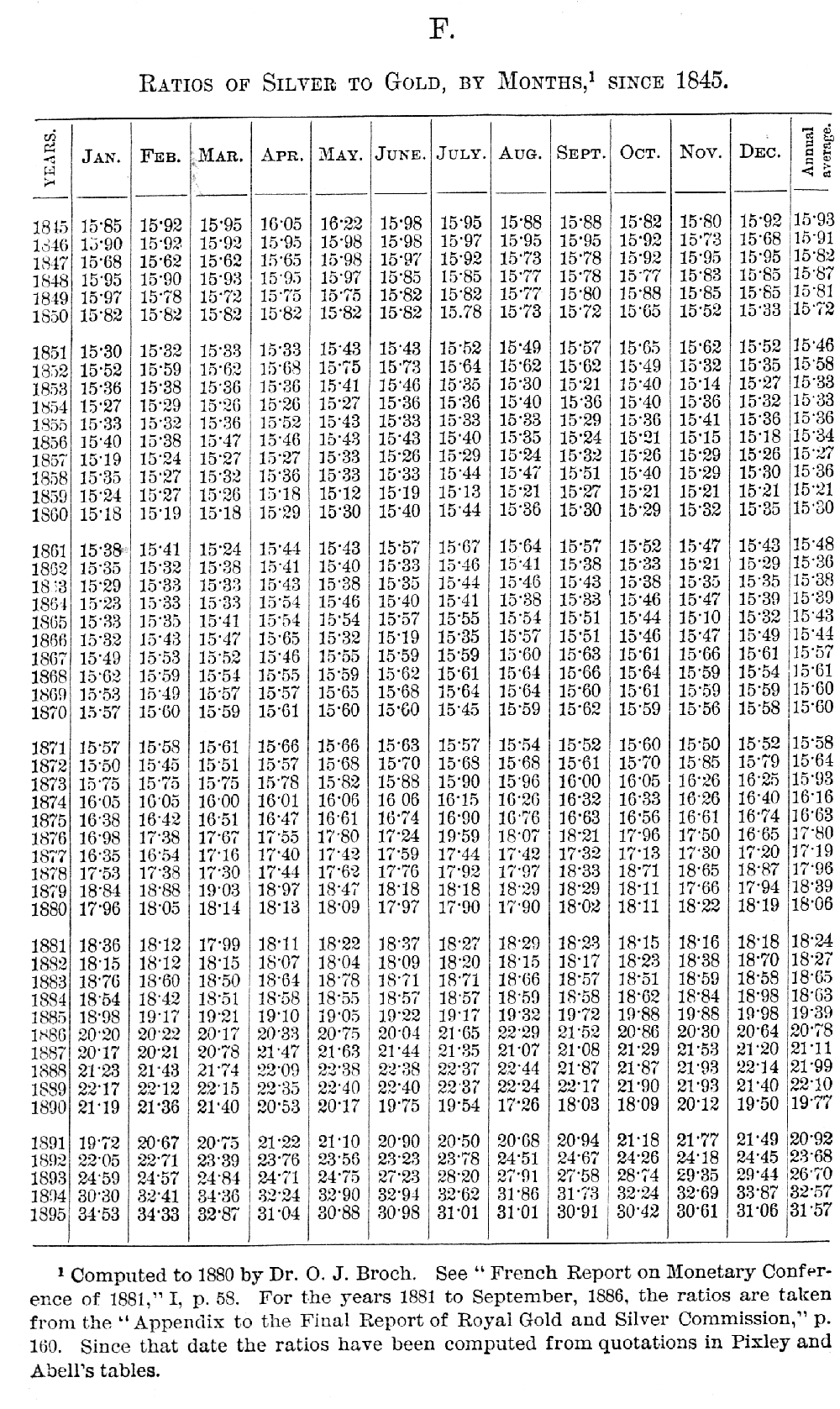
G. Method of Computing the Ratio from the London Price of Silver.
Rule.—Divide the number 943 by the number of pence at which silver is quoted.
In Great Britain 1869 sovereigns are to be struck out of 40 pounds troy of gold, 11/12 fine; and one ounce would be coined into 1869/(40×12) sovereigns, or £3 17
s. 10½
d., or 934½
d., 11/12 fine. The ounce of pure gold, therefore, is worth 934½
d. × 12/11.
If an ounce of silver of British standard, 37/40 fine, is quoted at
x pence, an ounce of pure silver would be worth
x × 40/37 pence.
The ratio of the value of an ounce of pure gold to an ounce of pure silver would be, therefore,

Method of Computing the Value of a Silver Dollar from New York Quotations.
Rule.—Multiply the price per ounce by .77 1/8.
The New York quotations, as given in the financial columns of the daily press, make allowance for changes from the London prices, due to the rate of exchange, etc.; but the quotations are for pure silver, that is, for silver 1,000 fine:
| In | 1000 | 412½-gr. | dollars are | 859 3/8 ounces of silver 900 fine. |
| “ | “ | trade | “ | 875 “ |
| “ | $1000 | subsid. | coin “ | 803¾ “ |
Since the New York quotations are given for silver 1,000 fine, but since our coins are made of silver 900 fine, the quotation should be multiplied by only 9/10 of the actual weight of the coins. The 859 3/8 ounces less 1/10 is 773.4375; and to multiply this last number by the quotation would give the value of 1,000 silver dollars. But the value of one dollar can be found by multiplying the price by 773.4375/1000 or approximately, by .77 1/8.
Appendix IV
